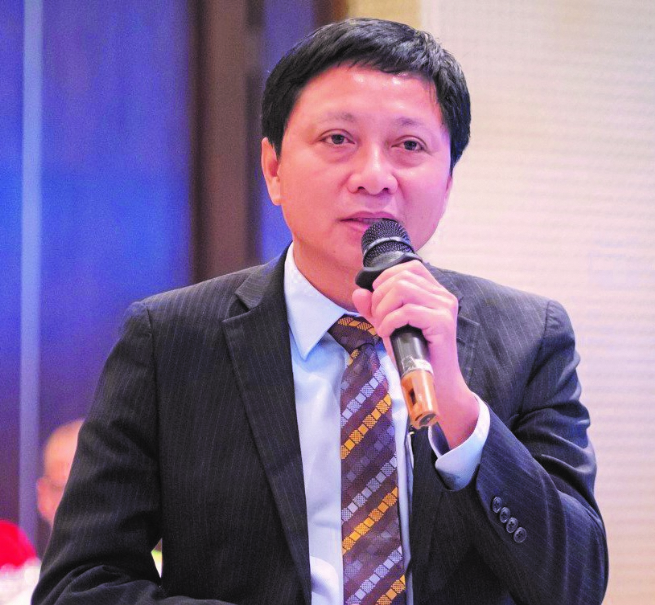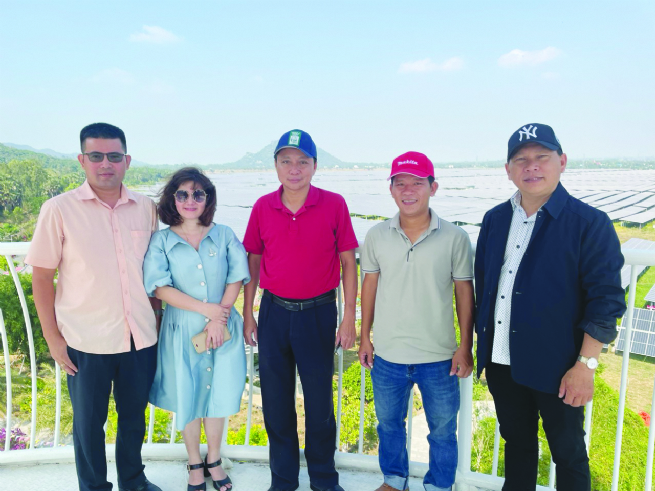10:13:30 AM | 4/7/2023
The Vietnam ASEAN Hydrogen Club (VAHC) was launched on March 17, 2023 in Ho Chi Minh City (Vietnam). According to Mr. Le Ngoc Anh Minh, Founding Member and Chairman of VAHC, VAHC is a member of the Vietnam ASEAN Friendship Association in Ho Chi Minh City. It is a forum for policymakers, scientists, project developers, financial investors, climate response sponsors and technologists of Vietnam and ASEAN.
 |
Mr. Le Ngoc Anh Minh expected that VAHC will become the main focal point of the hydrogen economy in Vietnam, ASEAN and the world; and aim to develop a sustainable hydrogen ecosystem. VAHC will also create favorable conditions for agencies and people to exchange experiences, share knowledge and connect with each other to foster the development of the hydrogen industry in Vietnam and ASEAN to contribute to sustainable development and reduction of harmful emissions.
Could you please tell us why VAHC was established?
As one of the countries heavily affected by climate change, in recent years, Vietnam has made clear commitments and taken many actions against climate change. In November 2021, at the United Nations Climate Change Conference (COP26) in Glasgow (United Kingdom), the Prime Minister set the target of net zero emissions for Vietnam by 2050. By December 2022, Vietnam signed with G7+2 countries (G7 Group plus Norway and Denmark) a US$15.5 billion grant to support clean energy transition (for Vietnam) under the Just Energy Transition Partnership (JETP). In the latest report on Power Planning 8 submitted to the Prime Minister, the Ministry of Industry and Trade also stated that power projects powered by fossil fuels will be converted to partial hydrogen burning and further to pure hydrogen burning by 2050.
As known, Vietnam is considered to have strengths in renewable energy development (wind power, solar power, tidal power, wave power, marine current power and biomass power) and can completely become a leading producer and exporter of renewable energy in the region. Recently, encouraged by the Government, the renewable energy industry has developed very strongly. By 2017, Vietnam stood in the Asia-Pacific region’s Top 3 in renewable energy and clean energy development. However, the massive investment in renewable energy projects has placed great pressures on the transmission infrastructure and caused some projects to fail in connection and full-capacity sale. Renewable energy, besides many known advantages, also has apparent disadvantages, such as dependency on the weather. Hence, policymakers and investors are urgently finding ways to set up electricity and hydrogen storage systems or fuel cells used for transportation are a viable option.
Looking to the world, countries in Southeast Asia and Northeast Asia are also actively converting energy as Vietnam has done. In particular, Japan, South Korea and China are committed to net zero by 2050 and 2060, thus urgently demanding an alternative clean fuel source in which hydrogen is a key fuel component. In this context, domestic and foreign investors are trying to form an energy storage mechanism in which hydrogen can play a key role.
Amid this reality, entrepreneurs and experts who are experienced in developing large-scale energy infrastructure, law and communication investment projects in Vietnam and in the world, and cooperating with international partners such as ASEAN and Japan, have researched, discussed and proposed the initiatives of establishing the Vietnam ASEAN Hydrogen Club (VAHC). With their passion and sense of responsibility, VAHC members will make efforts to establish the connection to enable and foster the development of the hydrogen industry and hydrogen economy in Vietnam and ASEAN.

Prime Minister Pham Minh Chinh discusses with investors at an investment conference
How will VAHC promote the above mission and vision?
VAHC will organize many activities: Opening conferences and seminars on environment, new energy, clean energy, renewable energy and hydrogen; hosting local, national, ASEAN and global workshops; drafting initiatives, proposing initiatives on clean energy and ESG initiatives; commenting on bills on clean energy, ESG, and hydrogen to the Government of Vietnam and ASEAN countries; holding exchanges on clean energy, renewable energy, hydrogen and industries, finance, investment and environmental resources related to the hydrogen economy among Vietnam, ASEAN and international partners in other regions; and hosting scientific and technical exchanges, research and development on clean energy, renewable energy, hydrogen and industries, finance, investment and environmental resources related to the hydrogen economy among Vietnam, ASEAN, as well as international partners in other regions.
VAHC members will take part in important forums on clean energy and hydrogen energy organized by Vietnam, ASEAN and international partners. VAHC wishes to cooperate extensively with leading universities, scientific institutes, government agencies, and leading industrial, financial, investment, natural resource and environmental partners of Vietnam, ASEAN and other international regions to achieve the goal of bringing Vietnam to net zero emissions by 2050, and deliver the goal of developing a hydrogen economy for Vietnam and ASEAN.

VAHC members pay a working to visit Sao Mai Group's An Hoa solar power plant
How are countries around the world replacing fossil fuels with hydrogen?
In 1960, General Electric Company produced hydrogen fuel cell power supply systems for NASA's Apollo spacecraft, later used for Apollo-Soyuz, Skylab and space shuttles. Today, NASA's space shuttles and research stations are powered by fuel cells because hydrogen and oxygen are carried on spaceships. But, interestingly, the fuel cell itself not only produces electricity but also provides super clean drinking water for astronauts because water is the waste product of hydrogen fuel cells.
At present, there are already many models of hydrogen cars, a combination of a hydrogen internal combustion engine and an electric engine called a hybrid car, which is also collectively known as Zero Emission Vehicle (ZEV) with famous brands including Honda, Ford and Mercedes-Benz. Japan announced that, right in 2008, ZEV cars would be manufactured, with the popular names being Toyota Prius, Toyota Camry Hybrid, Ford Escape Hybrid, Honda Insight and especially Toyota Mirai. By April 2007, the U.S. saw 200 hydrogen cars and buses in traffic. Recently, a ZEV test journey across Australia in a day, with a total length of about 4,000 km, showed that ZEVs can safely go anywhere without any gasoline and generate environment-harmless emissions.
Today, the hydrogen economy is becoming an irreversible trend in the world. In the US, in 2003, President George W. Bush announced the Hydrogen Fuel Initiative, which funded US$1.2 billion for research and development (R&D) aimed at successfully commercializing hydrogen cars by 2020. The solar-powered hydrogen economy is no longer a vague idea or science fiction. The hydrogen economy is likely to be realized in 25-35 years! As President Bush hoped, the child born at the beginning of his administration would be able to buy a hydrogen car as their first car.

The founding board of Vietnam ASEAN Hydrogen Club (VAHC)
Could you please share the simplest way how hydrogen becomes an energy source and how it replaces fossil energy sources?
Hydrogen (H2) is the lightest, most abundant element in the universe, existing around us in the form of compounds, with the most visible being water (H2O). Producing hydrogen is quite simple, just by using electricity to split water (H2O) into hydrogen (H2) and oxygen. The process of using electricity to split water into hydrogen and oxygen in a reverse reaction of water is electrolysis. Once generated, hydrogen can also be stored, used to produce electricity when needed. This is done through a fuel cell, which generates electricity by triggering a chemical reaction between hydrogen and oxygen. This is an environmentally friendly, clean process. Japanese researchers extracted hydrogen from lignite (brown coal): Hydrogen is generated by heating brown coal to trigger the release of several gasses, including hydrogen, carbon dioxide and nitrogen. Hydrogen is then extracted from other gasses and purified for use. Japan cooperated with Australia to carry out a lignite-based hydrogen production project and tested building a tanker to transport liquid hydrogen from Australia to Japan. In March 2023, the Japanese Government funded US$1.62 billion for this clean hydrogen project (Kawasaki Heavy Industries' ship technology in cooperation with Iwatani Corp to form a distribution chain while J Power and Sumitomo Corp separate hydrogen from brown coal in the Australian state of Victoria).
Hydrogen can also be produced from fossil fuels, especially converted natural gas, and many fuel cell vehicles (FCVs) today are also powered by this method. However, if hydrogen is produced purely from renewable energy such as wind power, hydropower and solar power, we will have a completely CO2-free process, from hydrogen production to electricity generation. Besides, hydrogen is also extremely versatile. It can be used to power everything, from ships to spacecraft, as well as office buildings, transport hubs, buses and cars. Since hydrogen can be stored, it will also be transported to where it is needed. Toyota Corporation built Woven City, an innovative smart city, on the foundation of a former textile factory of Toyota's founder. In Woven City, researchers are forming a hydrogen cartridge that will be a secondary energy source for vehicles as well as convenient housing. Consumers can go to the supermarket to buy hydrogen cartridges to install in their homes and have enough energy to use for electricity generation for a long time.
| Mr. Le Ngoc Anh Minh is currently the Executive Chairman of Pacific Group Co., Ltd. He has 28 years of experience in administering and developing large-scale projects in Vietnam, including Phu My 1 Combined Cycle Power Plant and Nhat Tan Bridge; 22 years of experience in leading mid-sized companies in Vietnam; and 15 years of experience in developing new businesses in Vietnam. He is an infrastructure investment expert in Vietnam, the founder of the Vietnam Clean & Creative Agriculture Club (VCAC), the chief representative of the BRICS-ASEAN Chamber of Commerce in Vietnam and the founder of the Hashi Manpower Club. |
Electricity from hydrogen fuel cells can be produced from anywhere, at any capacity, from a few W to hundreds of MW, for every need, from remote areas or power stations and buildings to cities without the need for massive power plants and grid power from national power supply and distribution centers. Consumers can produce their own electricity. Generating electricity with hydrogen fuel cells will break monopolistic electricity generation and distribution. The hydrogen economy will replace the fossil economy: The energy revolution is being realized and hydrogen and fuel cells are key to solving atmospheric pollution and global climate change. All these changes show that this is really a profound revolution in human social development and is as significant as previous industrial revolutions with steam engines powered by coal.
Thank you very much!
Ngo Khuyen, Vietnam Business Forum